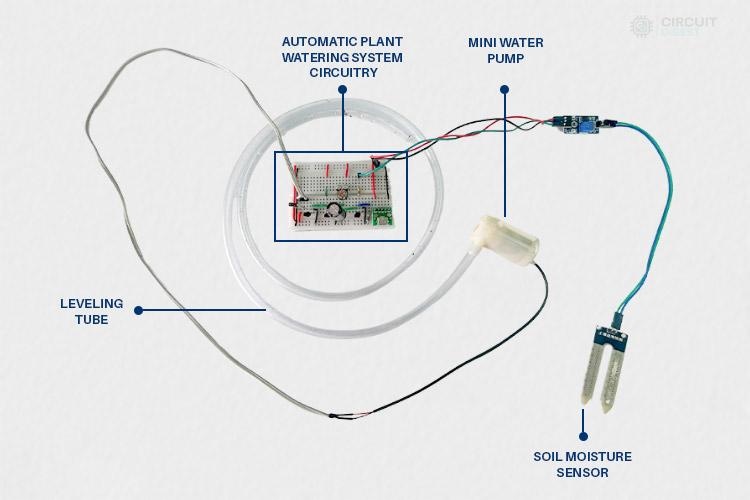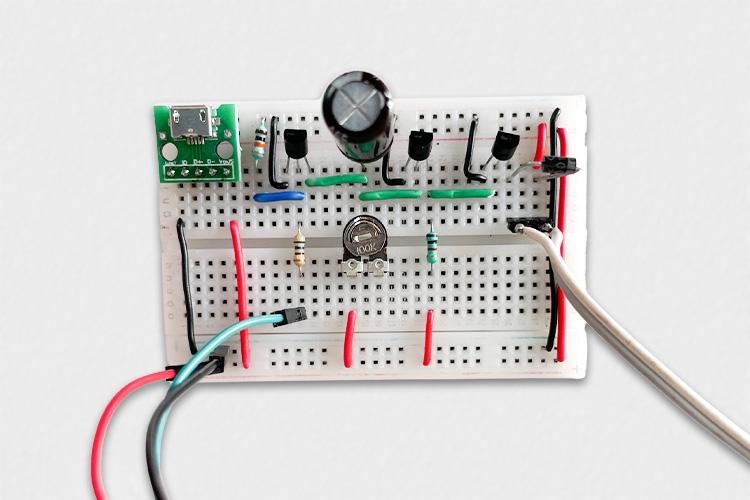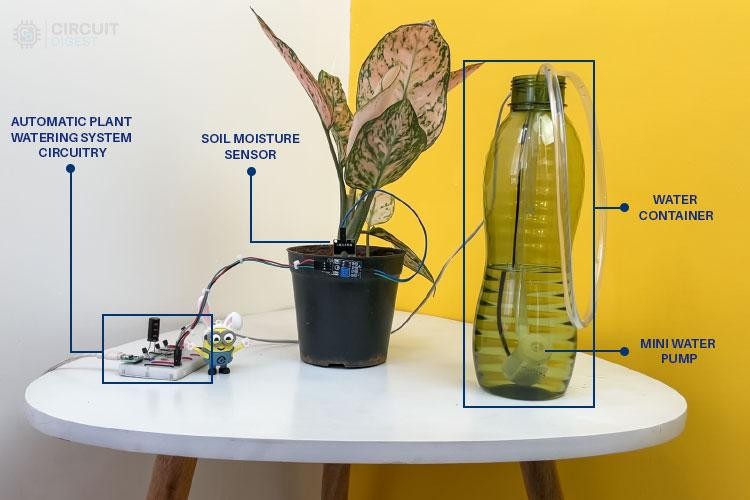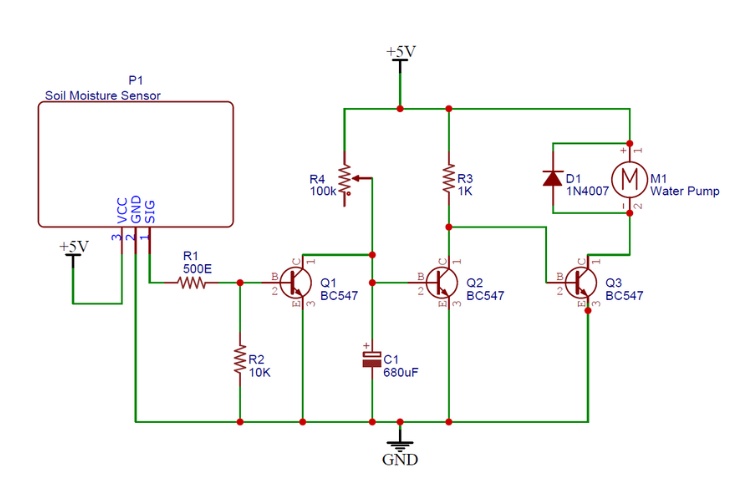
Nowadays, many people are turning towards green solutions to lead healthier lives. Efforts are being made to grow plants, which contribute to maintaining the stability of nature. The key challenge in growing plants is maintenance, particularly ensuring they receive adequate watering. Despite our best intentions, we may forget to water our plants at times. To address this, we have developed a very simple automatic plant watering system without Arduino. The idea is to use minimal components and reduce complexity so that everyone can easily build it. It's an ideal option for anyone who is trying to automatically water their potted plants during a vacation
Let’s see, how we can do that!
Features of Automatic Plant Watering System Project:
- Based on commonly used BC547.
- Easy to build.
- No need for coding.
- Low-cost design.
- Easy availability of components.
- Has a built-in adjustable delay function.
Components Required to Build Self Plant Watering System:
Required Components are listed below to build the simple Automatic plant watering system,
- Soil Moisture Sensor - x1
- BC547 - x3
- Electrolytic Capacitor - 680uf - x1
- Resistor -
- ○ 10k-x1
- ○ 1k-x1
- ○ 500E-x1
- 100k Ohm Potentiometer - x1
- Bread Board - x1
- Mini Water Pump (3-6v) - x1
- Mini Water Tube suitable for pump- Required Length.
- 5V Power Source - Any
Circuit Diagram Indoor Automatic Plant Watering System:
Below is the circuit diagram of the Automatic plant watering system, as you can see this circuit diagram was so simple and beginner-friendly. If you are not comfortable using components like transistors and resistors you can try check out our alternate project which uses Arduino for Automatic Plan watering system.
Here, the soil moisture sensor is the main component to detect the presence of water in the soil. You can visit our Well written article to learn how the soil moisture sensor works. You may think that with the addition of a single transistor to switch the motor, our circuit can be completed, but yeh here are still two transistors used. It looks simple at the beginning but if you think carefully there is the problem that if the motor is turned on for a very short duration it might trigger the motor more often and there will be a need for proper watering of the plant.
So, to solve this issue we are utilizing the simplest timer circuit known as RC Timer Which can be seen below. Depending on the value of the resistor and capacitor we can make the time delay of up to a few seconds. As an advantage, we added a potentiometer to make this time delay adjustable.

Next, you can understand that the Transistor Q1 is used to discharge the capacitor whenever the HIGH signal is received from the Soil Moisture sensor. The output from the RC Timer is Connected to the Q2, which here works as an inverter. So therefore, I am using Q3 to drive the motor.
You may confuse that Q2 itself can drive the motor instead of being an inverter. Yeah, of course, it can be used to drive a motor if your sensor provides Low for Dryness. But Most of the sensors out there will provide High for Dryness and Low for Wetness. You can refer to the table provided below for a brief understanding.
| Sensor Input | Sensor Output | Inverter Requirement | Expected Water Pump State |
| Wetness | HIGH | YES | OFF |
| Wetness | LOW | NO | OFF |
| Dryness | LOW | YES | ON |
| Dryness | HIGH | NO | ON |
Components Assembly of the Automatic Plant Watering System:
To make this simple our preference is to make use of breadboard. If you think to make it more stable you can also solder it to a Dotted PCB and keep it in any small enclosure. You can see the assembled image of the components, made in the breadboard below. We Increased the length of the Wire given in the water Pump and talking about the pump I appreciate you checking the perfectness of the waterproofing of the motor, if not make a proper seal by yourself using some sort of gum or even hot glue works well.

And the main thing we need to discuss here is Power supply. This circuit was made in a way to accept 5V DC input. There are numerous ways to power this circuit like using DC Power Adapters, Mobile chargers, Power banks, etc. I am using a Micro USB Breakout Module to power up the circuit using a USB Cable Connected with the power bank, which can be seen below.

Ensure that the Proper Connections are made between the components and then we can start the installation.
I selected a small indoor plant pot and installed the humidity sensor along with the tube from the water pump, and the water pump itself was placed in the bottle with the big mouth so that the motor could be installed straightaway. The remaining circuit was placed near the pot and powered by the power bank. This Setup can be seen below.

Automatic Plant Watering System using TinkerCad:
Let's simulate the Automatic Plant Watering System using TinkerCad before moving on to a real-time working demonstration. Below, you can access the TinkerCad simulation for the Automatic Plant Watering System:
In the simulation, you'll notice that the working logic appears inverted. This is due to the sensor available in TinkerCad providing an inverted output. However, apart from this inversion, the overall logic and components remain the same.
Working Demo of the Automatic Plant Watering System Project:
As already discussed, this project works by detecting dryness in the soil using a soil moisture sensor and switching ON the mini water pump by now the water starts flowing from the water storage to the Flowerpot and will be turned OFF after a certain amount of delay set via potentiometer once it detects wetness inside the pot. The below video shows how this automatic watering system for potted plants works.
That’s all, we completed our Project.
Here are some hacks you can do in this automatic plant waterer project.
- You can change the Q3-BC547_General Purpose NPN Transistor to some other NPN transistor to increase the current capacity to drive the higher power motors.
- C1 can be changed as per your need. Using the trial-and-error method, you can find the most suitable one.
- You can use a battery system consisting of a Single Li-ion cell, a DC-DC Boost Converter, Battery Charging, and a Protection Circuit to make this project portable.
- Apart from this concept of an Automatic Plant Watering system, this circuit has many scopes.
Discover Exciting Projects in a Similar Realm:
If you are interested in building more such projects check out our collection of Arduino Projects. We have more than 500 projects with Code and Circuit Diagram that you can use to build your projects today.
1. How Does a Soil Moisture Sensor Work and How to use it with Arduino?: Curious about soil moisture sensors? This article explains how they work and shows you how to use them with Arduino.
2. Simple Soil Moisture Detector Circuit: Build your own soil moisture sensor with an easy-to-follow circuit.
3. Arduino-based Automatic Plant Irrigation System with Message Alert: Learn to create an automatic plant watering system using Arduino and get text message alerts using the Sim800l module. You'll also set up a 16x2 LCD display for feedback.
4. Low Power IoT Based Compact Soil Moisture Monitoring Device: Make your own battery-powered smart soil moisture sensor using IoT technology, focusing on the ESP8266 module as the main controller.
5. Arduino Smart Irrigation System Using ESP32 and Blynk App: Explore a smart irrigation setup with Arduino and ESP32. This project goes beyond soil moisture sensing, incorporating water level, humidity, and temperature sensors. Discover how to use IoT features with Blynk.






